Chicago, Illinois Mold Information to help you!

Chicago Mold Facts and Information
The CleanUP Guys is a Chicago restoration company that specializes in mold removal, water damage restoration, and flood damage restoration. If you need immediate assistance, please call (773) 885-8528.
This article explains what mold is, the common types of mold, common mold species, why mold grows, and how to detect mold!
What Causes Mold Growth?
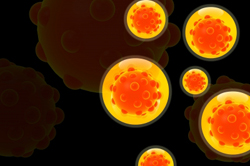
What Causes Mold Growth?
Mold is a fungus, as are mushrooms and yeast, and has a biological purpose in our eco-system: to consumes dead organic material. Understanding it?s biological importance is essential to understanding why it poses health hazards.
Problems occur with mold when it begins growing in an enclosed environment such as a home. Mold found inside homes and buildings originates from the outside. Mold spores enter buildings and homes through open doorways, windows, heating, ventilation and air conditioning systems. Spores in the air outside also attach themselves to clothing, animals, shoes, bags and more!
The key ingredient mold needs to thrive and grow is moisture and a food source.
Sources of Moisture That Promote Mold Growth
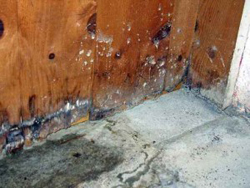
Sources of Moisture
Since mold is everywhere, it will only start growing when the spores settle on surfaces with excess moisture. The key to preventing mold growth is to control moisture. Maintaining an interior humidity level of between 30 to 40% will prevent mold growth.
Listed below are the most common sources of moisture. If you suspect mold growth, before the mold can be cleaned and removed, the sources of the moisture issues must be addressed first.
1. Flooding.
2. Backed-up sewers.
3. Leaky roofs and/or water leaks.
4. Humidifier which is not regularly cleaned and disinfected.
5. Damp basements or crawl spaces.
6. House plants and their debris.
7. Steam from cooking and showers.
8. Wet clothes hung to dry indoors.
9. Inadequate air exchange.
10. Excessive humidity.
11. Condensation, which is especially a problem during the winter, on poorly insulated surfaces.
Sources of Food For Mold
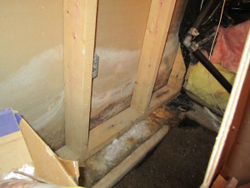
Sources of Food
Mold is like a parasite because it will only grow if there is an ample mold source. Under the right conditions of temperature and moisture, mold will continue to feed. The problem with mold lies in the fact that most homes and buildings are made from dead organic material, which is the type of food that mold thrives on. Food sources for mold include the following:
1. Wood & wood products.
2. Paper and other paper products like cardboard and wallpaper
3. Leather.
4. Fabric and upholstery
5. Grout.
6. Painted walls.
7. Cement
8. Plaster (drywall).
9. Ceiling tiles
10. Insulation materials.
11. Carpet.
What Are The Most Common Types and Species of Mold?
Not all molds are the same; consequently, it is important to understand that identifying the types and species of mold is important because it helps you and the mold remediation professionals assess the potential health hazards that the growth poses.
There Are Three Types of Mold
Of the 100,000 types of mold that have been identified, the three most common types have been identified as:
1. Allergenic Molds.
2. Pathogenic Molds.
3. Toxigenic Molds.
Types of Mold: Allergenic Molds
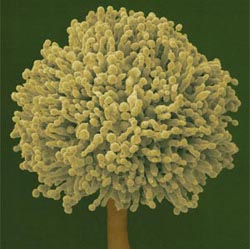
Allergenic Molds
Allergenic molds are not usually life-threatening but do cause health concerns for individuals with allergies or asthma. Children and the elderly are most likely to experience health issues if there are allergenic molds present in the property.
Types of Mold: Pathogenic Molds
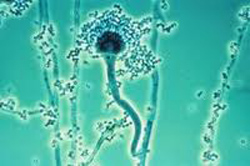
Pathogenic Molds
Pathogenic molds are of particular concern if your immune system is weak or compromised because these can cause infections. This type of mold can cause hypersensitivity pneumonitis, an acute response resembling bacterial pneumonia. An example is Aspergillus fumigatus, which can grow in the lungs of immune-compromised individuals.
Types of Mold: Toxigenic Molds (aka ?toxic molds?)
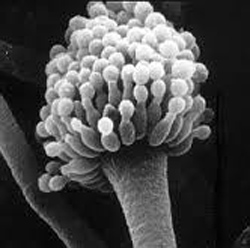
Toxigenic Molds
Toxigenic molds are the worse types of molds because they produce mycotoxins that will make anyone exposed to them sick. Mycotoxins are chemical toxins present within or on the surface of the mold spore, which can be inhaled, ingested, or touched. An example of this is an aflatoxin, one of the most potent carcinogens known to mankind. Aflatoxins grow on peanuts and grains, and on some other foods.
There Are Five Species of Mold
Mold inspectors and indoor air quality professionals use various methods to identify the mold species.
Testing could be done with a tape or swab sample on visible mold.
Air quality samples may also be recommended because air borne mold spores are not visible to the eye. Air quality samples are advantageous because they can identify the concentration of indoor spores.
Once samples are taken, they should be sent to accredited laboratories to analyze them to determine the exact species of mold.
The five most prevalent species of mold are:
1. Alternaria.
2. Aspergillus.
3. Cladosporium.
4. Penicillium.
5. Stachybotrys.
Species of Mold: Alternaria Mold
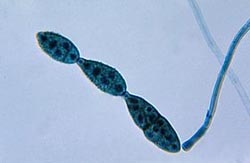
Alternaria Mold
Alternaria mold is commonly found in your nose, mouth and upper respiratory tract and can cause allergic responses.
Species of Mold: Aspergillus Mold
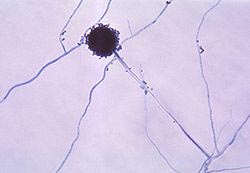
Aspergillus Mold
Aspergillus mold is usually found in warm, extremely damp climates, and a common occupant of house dust. This mold produces mycotoxins which is a poisonous chemical compound. This mold variety can cause lung infections including aspergillosis.
Species of Mold: Cladosporium Mold
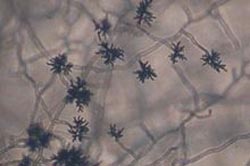
Cladosporium Mold
Cladosporium mold is a very common outdoor fungus that can find its way indoors and grow on textiles, wood and other damp, porous materials. This mold triggers hay fever and asthma symptoms.
Species of Mold: Penicillium Mold
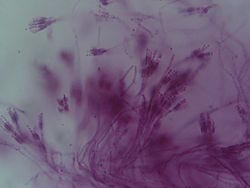
Penicillium Mold
Penicillium mold is a very common species found on wallpaper, decaying fabrics, carpet, and fiberglass duct insulation. It is known for causing allergies and asthma. Some species produce mycotoxins, one being the common antibiotic penicillin.
Species of Mold: Stachybotrys Mold
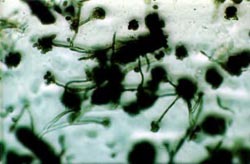
Stachybotrys Mold
Stachybotrys mold is extremely toxic ?black mold? that produces mycotoxins that can cause serious breathing difficulties and bleeding of the lungs. This mold can be found on wood or paper.
Why Should I Be Concerned About Mold?
There are two key reasons you should be concerned about mold:
1. Health.
2. Structural Integrity of Property.
Health Reasons You Should Be Concerned About Mold

Health Reasons
When mold is disturbed, spores become airborne increasing the likelihood of breathing spores in. While some people are not affected by mold spores, others sharing the same environment infested with mold can have severe reactions. Mold spore exposure can also cause adverse health effects in immune compromised individuals. Individuals sensitive to mold exposure can suffer from nasal stuffiness, eye irritation, wheezing and more. In addition, people with chronic illnesses, such as asthma or obstructive lung disease, may develop mold infections in their lungs. Allergic reactions, similar to common pollen or animal allergies, are the most common health effects in individuals sensitive to mold. Flu-like symptoms and skin rashes can also occur.
Structural Integrity Is Another Cause For Concern About Mold
In addition to the health concerns, it is also important to realize that like a parasite mold will continue to feed on its host, causing significant structural concerns.
How Can I Detect Mold?
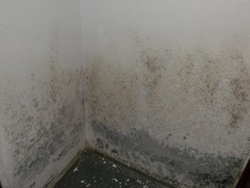
How Can I Detect Mold
Mold can be detected through smell, visual clues, and knowledge of the building history, ie. was there a flood or indoor leak. We recommend that the advice of a professional be sought because they have specialized tools and knowledge to identify the cause of the mold growth, ie. the source of moisture, and then make recommendations on how to remove the mold after the moisture problem has been fixed.
Visual Signs of Mold
Check for visible signs of mold growth. Molds may appear in colors such as gray, white, black, or green. Black mold, stachybotris, is especially dangerous.
Smell
A mildewy or moldy smell is a strong indication that mold is present.
Flooding or Indoor Leaks
If you experienced flooding or found a leak that has not been fixed for some time, there is a strong possibility that you will have mold growth because mold thrives in moisture.
Winter Mist
Generally when it?s cold, there is an excess in moisture. Excess humidity in the environment can cause mold growth. Ice Damning issues are a concern.
Hidden Molds
Hidden molds are particularly hard to find. However, if you smell a stale mildewy odor or have allergic symptoms when close to a source with no visual mold, this may be a clue that there is a hidden mold source.
Hire a Professional Mold Inspector
We strongly recommend that you hire a Certified Inspector to determine if you have a mold issue. Professionals follow a set procedure which starts with an interview to learn more about the building history, moisture readings to determine if there is a source of moisture required for mold growth, and visual inspections. During the meeting, the inspector may even recommend thermal imaging if an identifiable moisture source is not present, but mold is detected. Other recommendations may include a swab test, tape sample, or air quality test to determine the type of mold and spore count present. Ultimately, the goal of the mold inspection is to determine the extent of the mold problem so recommendations can be made to bring the fungal ecology to a healthy level.
If you have questions or suspect you have mold issues, call (773) 885-8528., or use send us an e-mail.
Chicago, Illinois Mold Information: This article explains what #mold is, the common types of mold, common mold species, why mold grows, and how to detect mold!
Posted by The CleanUP Guys, Inc on?Tuesday, February 2, 2016
#Chicago, Illinois #Mold Facts https://t.co/w5hAvJzwrw PLEASE RETWEET pic.twitter.com/DJ1lYOt6sw
? The CleanUP Guys (@TheCleanUpGuys) February 2, 2016
